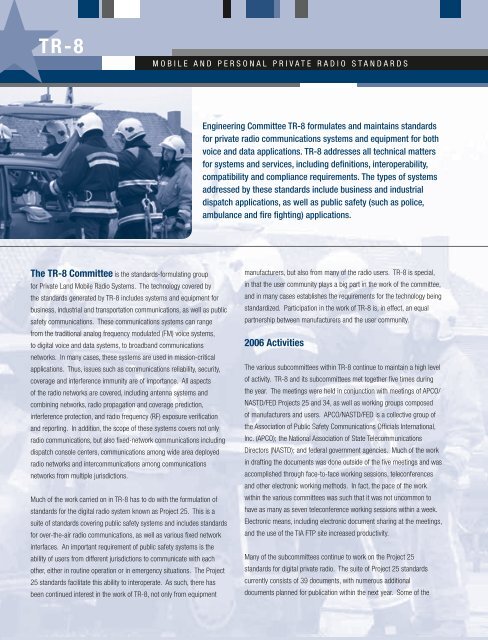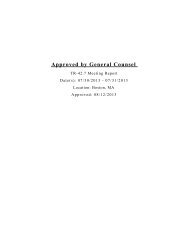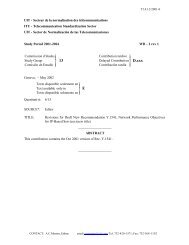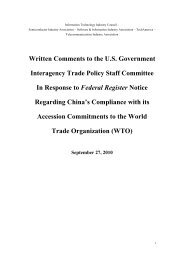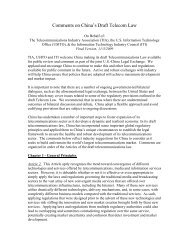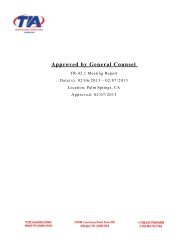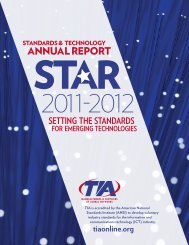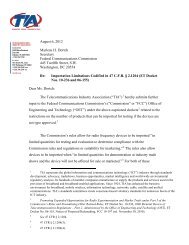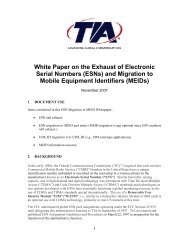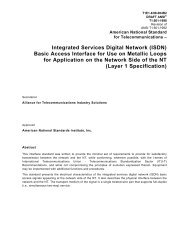TIA:STAR - Telecommunications Industry Association
TIA:STAR - Telecommunications Industry Association
TIA:STAR - Telecommunications Industry Association
Create successful ePaper yourself
Turn your PDF publications into a flip-book with our unique Google optimized e-Paper software.
TR-8<br />
MOBILE AND PERSONAL PRIVATE RADIO STANDARDS<br />
Engineering Committee TR-8 formulates and maintains standards<br />
for private radio communications systems and equipment for both<br />
voice and data applications. TR-8 addresses all technical matters<br />
for systems and services, including definitions, interoperability,<br />
compatibility and compliance requirements. The types of systems<br />
addressed by these standards include business and industrial<br />
dispatch applications, as well as public safety (such as police,<br />
ambulance and fire fighting) applications.<br />
The TR-8 Committee is the standards-formulating group<br />
for Private Land Mobile Radio Systems. The technology covered by<br />
the standards generated by TR-8 includes systems and equipment for<br />
business, industrial and transportation communications, as well as public<br />
safety communications. These communications systems can range<br />
from the traditional analog frequency modulated (FM) voice systems,<br />
to digital voice and data systems, to broadband communications<br />
networks. In many cases, these systems are used in mission-critical<br />
applications. Thus, issues such as communications reliability, security,<br />
coverage and interference immunity are of importance. All aspects<br />
of the radio networks are covered, including antenna systems and<br />
combining networks, radio propagation and coverage prediction,<br />
interference protection, and radio frequency (RF) exposure verifi cation<br />
and reporting. In addition, the scope of these systems covers not only<br />
radio communications, but also fi xed-network communications including<br />
dispatch console centers, communications among wide area deployed<br />
radio networks and intercommunications among communications<br />
networks from multiple jurisdictions.<br />
Much of the work carried on in TR-8 has to do with the formulation of<br />
standards for the digital radio system known as Project 25. This is a<br />
suite of standards covering public safety systems and includes standards<br />
for over-the-air radio communications, as well as various fi xed network<br />
interfaces. An important requirement of public safety systems is the<br />
ability of users from different jurisdictions to communicate with each<br />
other, either in routine operation or in emergency situations. The Project<br />
25 standards facilitate this ability to interoperate. As such, there has<br />
been continued interest in the work of TR-8, not only from equipment<br />
manufacturers, but also from many of the radio users. TR-8 is special,<br />
in that the user community plays a big part in the work of the committee,<br />
and in many cases establishes the requirements for the technology being<br />
standardized. Participation in the work of TR-8 is, in effect, an equal<br />
partnership between manufacturers and the user community.<br />
2006 Activities<br />
The various subcommittees within TR-8 continue to maintain a high level<br />
of activity. TR-8 and its subcommittees met together fi ve times during<br />
the year. The meetings were held in conjunction with meetings of APCO/<br />
NASTD/FED Projects 25 and 34, as well as working groups composed<br />
of manufacturers and users. APCO/NASTD/FED is a collective group of<br />
the <strong>Association</strong> of Public Safety Communications Offi cials International,<br />
Inc. (APCO); the National <strong>Association</strong> of State <strong>Telecommunications</strong><br />
Directors (NASTD); and federal government agencies. Much of the work<br />
in drafting the documents was done outside of the fi ve meetings and was<br />
accomplished through face-to-face working sessions, teleconferences<br />
and other electronic working methods. In fact, the pace of the work<br />
within the various committees was such that it was not uncommon to<br />
have as many as seven teleconference working sessions within a week.<br />
Electronic means, including electronic document sharing at the meetings,<br />
and the use of the <strong>TIA</strong> FTP site increased productivity.<br />
Many of the subcommittees continue to work on the Project 25<br />
standards for digital private radio. The suite of Project 25 standards<br />
currently consists of 39 documents, with numerous additional<br />
documents planned for publication within the next year. Some of the<br />
4<br />
2006 STANDARDS AND TECHNOLOGY ANNUAL REPORT


